Thermal Effects on the Soil Water Retention Curves and Hydraulic Properties of Benggang Soil in Southern China
Abstract
1. Introduction
2. Materials and Methods
2.1. Study Area Overview
2.2. Soil Samples
2.3. Test Methods of Calibration Curves of Filter Paper and SWRC
2.3.1. Filter Paper Suction Calibration Test
- Specimen preparation
- 2.
- Sampling and testing process
- 3.
- Calibration curve of filter paper
2.3.2. Soil Sample Suction Test
2.4. SWRC Model
2.5. Data Processing and Statistics
3. Results
3.1. Effect of Temperature on the SWRCs of the Different Soil Layers
3.1.1. Differences in the SWRCs of the Different Soil Layers
3.1.2. Effect of Temperature on the SWRCs of the Different Soil Layers
3.1.3. Influence of Temperature on the Parameters of the SWRCs
3.2. Effect of Temperature on the Distribution of the Soil Equivalent Pore Diameter
3.3. Effect of Temperature on the Unsaturated Hydraulic Conductivity of the Soil
4. Discussion
4.1. Differences in the SWRCs of the Different Soil Layers in the Collapsing Gully Wall
4.2. Effect of Temperature on the SWRCs of Different Soil Layers in the Collapsing Gully Wall
4.3. Effect of Temperature on the Unsaturated Hydraulic Conductivity of the Soil in the Different Soil Layers of the Collapsing Gully Wall
5. Conclusions
Supplementary Materials
Author Contributions
Funding
Data Availability Statement
Conflicts of Interest
References
- Jiang, F.-S.; Huang, Y.-H.; Wang, M.-K.; Lin, J.-S.; Zhao, G.; Ge, H.-L. Effects of rainfall intensity and slope gradient on steep colluvial deposit erosion in southeast China. Soil Sci. Soc. Am. J. 2014, 78, 1741–1752. [Google Scholar] [CrossRef]
- Wei, Y.; Liu, Z.; Wu, X.; Zhang, Y.; Cui, T.; Cai, C.; Guo, Z.; Wang, J.; Cheng, D. Can Benggang be regarded as gully erosion? Catena 2021, 207, 105648. [Google Scholar] [CrossRef]
- Xia, J.; Cai, C.; Wei, Y.; Wu, X. Granite residual soil properties in collapsing gullies of South China: Spatial variations and effects on collapsing gully erosion. Catena 2019, 174, 469–477. [Google Scholar] [CrossRef]
- Li, C.; Kong, L.; Shu, R.; An, R.; Zhang, X. Disintegration characteristics in granite residual soil and their relationship with the collapsing gully in South China. Open Geosci. 2020, 12, 1116–1126. [Google Scholar] [CrossRef]
- Feng, M.H.; Liao, C.Y.; Li, S.X.; Lu, S.L. Investigation on Status of Hill Collapsing and Soil Erosion in Southern China. Yangtze River 2009, 40, 66–68+75, (In Chinese with English Abstract). [Google Scholar]
- Deng, Y.; Duan, X.; Ding, S.; Cai, C.; Chen, J. Suction stress characteristics in granite red soils and their relationship with the collapsing gully in South China. Catena 2018, 171, 505–522. [Google Scholar] [CrossRef]
- Deng, Y.-S.; Xia, D.; Cai, C.-F.; Ding, S.-W. Effects of land uses on soil physic-chemical properties and erodibility in collapsing-gully alluvial fan of Anxi County, China. J. Integr. Agric. 2016, 15, 1863–1873. [Google Scholar] [CrossRef]
- Duan, X.; Deng, Y.; Tao, Y.; He, Y.; Lin, L.; Chen, J. The soil configuration on granite residuals affects Benggang erosion by altering the soil water regime on the slope. Int. Soil Water Conserv. Res. 2021, 9, 419–432. [Google Scholar] [CrossRef]
- Wang, H.; Zou, J.; Wu, W.; Ni, W. Assessing unsaturated permeability of loess under multiple rainfalls. Eng. Geol. 2023, 324, 107280. [Google Scholar] [CrossRef]
- Rahimi, A.; Rahardjo, H.; Leong, E.C. Effects of soil–water characteristic curve and relative permeability equations on estimation of unsaturated permeability function. Soils Found. 2015, 55, 1400–1411. [Google Scholar] [CrossRef]
- Zhang, C.; Lu, N. Unified Effective Stress Equation for Soil. J. Eng. Mech. 2020, 146, 04019135. [Google Scholar] [CrossRef]
- Lu, N.; Dong, Y. Validating a unified effective stress equation for soil. J. Geotech. Geoenviron. 2022, 148, 02822001. [Google Scholar] [CrossRef]
- Kelishadi, H.; Mosaddeghi, M.; Ayoubi, S.; Mamedov, A. Effect of temperature on soil structural stability as characterized by high energy moisture characteristic method. Catena 2018, 170, 290–304. [Google Scholar] [CrossRef]
- Shao, M.A.; Wang, Q.J.; Huang, M.B. Soil Physics; Higher Education Press: Beijing, China, 2006. [Google Scholar]
- Hopmans, J.W.; Dane, J.H. Effect of Temperature-dependent Hydraulic Properties on Soil Water Movement. Soil Sci. Soc. Am. J. 1985, 49, 51–58. [Google Scholar] [CrossRef]
- Hopmans, J.W.; Dane, J.H. Temperature Dependence of Soil Hydraulic Properties. Soil Sci. Soc. Am. J. 1986, 50, 4–9. [Google Scholar] [CrossRef]
- Hopmans, J.; Dane, J.H. Temperature Dependence of Soil Water Retention Curves. Soil Sci. Soc. Am. J. 1986, 50, 562–567. [Google Scholar] [CrossRef]
- Pham, T.A.; Hashemi, A.; Sutman, M.; Medero, G.M. Effect of temperature on the soil–water retention characteristics in unsaturated soils: Analytical and experimental approaches. Soils Found. 2023, 63, 101301. [Google Scholar] [CrossRef]
- Pham, T.; Sutman, M. Modeling the combined effect of initial density and temperature on the soi1 water characteristic curve of unsaturated soils. Acta Geotech. 2023, 18, 6427–6455. [Google Scholar] [CrossRef]
- Philip, J.R. Theory of Infiltration. Adv. Hydrosci. 1969, 5, 215–296. [Google Scholar]
- De Vires, D.A. Chapter 7: Thermal Properties of Soils. Physics of Plant Environment; van Wijk, W.R., Ed.; Wiley: New York, NY, USA, 1963; pp. 210–235. [Google Scholar]
- Zhang, L.; Sun, S.; Lin, M.; Feng, K.; Zhang, Y.; Lin, J.; Ge, H.; Huang, Y.; Jiang, F. Study on soil-water characteristic curves in the profiles of collapsing walls of typical granite Benggang in southeast China. PeerJ 2022, 10, e13526. [Google Scholar] [CrossRef]
- Ye, W.-M.; Wan, M.; Chen, B.; Chen, Y.-G.; Cui, Y.-J.; Wang, J. Effect of temperature on soil-water characteristics and hysteresis of compacted Gaomiaozi bentonite. J. Cent. South Univ. Technol. 2009, 16, 821–826. [Google Scholar] [CrossRef]
- Gao, H.B.; Shao, M.A. Effects of temperature changes on soil hydraulic properties. Soil Tillage Res. 2015, 153, 145–154. [Google Scholar] [CrossRef]
- Roshani, P.; Sedano, I.Á.J. Incorporating Temperature Effects in Soil-Water Characteristic Curves. Indian Geotech. J. 2016, 46, 1–10. [Google Scholar] [CrossRef]
- Gong, Z.T.; Lei, W.J.; Chen, Z.C.; Gao, Y.X.; Zeng, S.G.; Zhang, G.L.; Xiao, D.N.; Li, S.G. Chinese soil taxonomy. BCAS 2007, 21, 36–38. [Google Scholar]
- SL/T 237-1999; Test Methods of Soils. China Water and Power Press: Beijing, China, 1999. (In Chinese)
- Hu, W.; Shao, M.; Wang, Q.; Li, Y. Effects of sampling size on measurements of soil saturated hydraulic conductivity. Acta Pedol. Sin. 2005, 42, 1040–1043, (In Chinese with English Abstract). [Google Scholar]
- ASTM Standard D 5298-94. Standard test method for measurement of soil potential (suction) using filter paper. Annu Book ASTM Stand. 1997, 4, 1312–1316. [Google Scholar]
- Bulut, R.; Wray, W.K. Free energy of water suction in filter papers. Geotech. Test. J. 2005, 28, 355–364. [Google Scholar]
- Qin, W.J.; Fan, G.S. Estimating parameters for the Van Genuchten model from soil physical-chemical properties of undisturbed loess-soil. Earth Sci. Inform. 2021, 14, 1563–1570. [Google Scholar] [CrossRef]
- Van Genuchten, M.T.; Leij, F.J.; Yates, S.R. The RETC Code for Quantifying the Hydraulic Functions of Unsaturated Soils; Robert, S.K., Ed.; Environmental Research Laboratory, Office of Research and Development, U.S. Environmental Protection Agency: Washington, DC, USA, 1992; pp. 9–21.
- Van Genuchten, M.T. A Closed-form Equation for Predicting the Hydraulic Conductivity of Unsaturated Soils. Soil Sci. Soil Sci. Soc. Am. J. 1980, 44, 892–898. [Google Scholar] [CrossRef]
- Mcqueen, I.S.; Miller, R.F. Approximating soil moisture characteristics from limited data: Empirical evidence and tentative model. Water Resour. Res. 1974, 10, 521–527. [Google Scholar] [CrossRef]
- Deng, Y.; Ding, S.; Cai, C. Characteristic Curves and Model Analysis of Soil Moisture in Collapse Mound Profiles in Southeast Hubei. Acta Pedol. Sin. 2016, 53, 355–364, (In Chinese with English Abstract). [Google Scholar]
- Xia, D.; Deng, Y.; Wang, S.; Ding, S.; Cai, C. Fractal features of soil particle-size distribution of different weathering profiles of the collapsing gullies in the hilly granitic region, southern China. Nat. Hazards 2015, 79, 455–478. [Google Scholar] [CrossRef]
- Schneider, M.; Goss, K.U. Temperature dependence of the water retention curve for dry soils. Water Resour. Res. 2011, 47, 1–5. [Google Scholar] [CrossRef]
- Grant, S.A.; Bachmann, J. Effect of Temperature on Capillary Pressure. Geophysical Monograph; American Geophysical Union: Washington, DC, USA, 2002; pp. 199–212. [Google Scholar]
- Luo, L.P.; Wang, H.; Zhu, J.B.; Tan, S.; Hu, C.W.; Chen, X.Y.; Ye, L. Difference Analysis of Temperature Effect on Water Characteristic Curves of Red Soil and Paddy Soil in South China. J. Soil Water Conserv. 2019, 33, 72–78+84. [Google Scholar]
- Paaswell, R.E. Temperature effects on clay consolidation. J. Soil Mech. Found. Engrg. Div. ASCE 1967, 93, 9–21. [Google Scholar] [CrossRef]
- Guo, Q.E.; Wang, Y.Q.; Che, Z.X.; Nan, L.L.; Cao, S.Y. Effect of Temperature and Degree of Mineralization on the Water-Retention Properties of Soil. J. Irrig Drain 2012, 31, 52–55, (In Chinese with English Abstract). [Google Scholar]
- Zhang, Y.; Zhao, D.; Zheng, Q.; Huang, Y.; Jiang, F.; Wang, M.-K.; Lin, J.; Huang, Y. Evaluating the effects of temperature on soil hydraulic and mechanical properties in the collapsing gully areas of south China. Catena 2022, 218, 106549. [Google Scholar] [CrossRef]
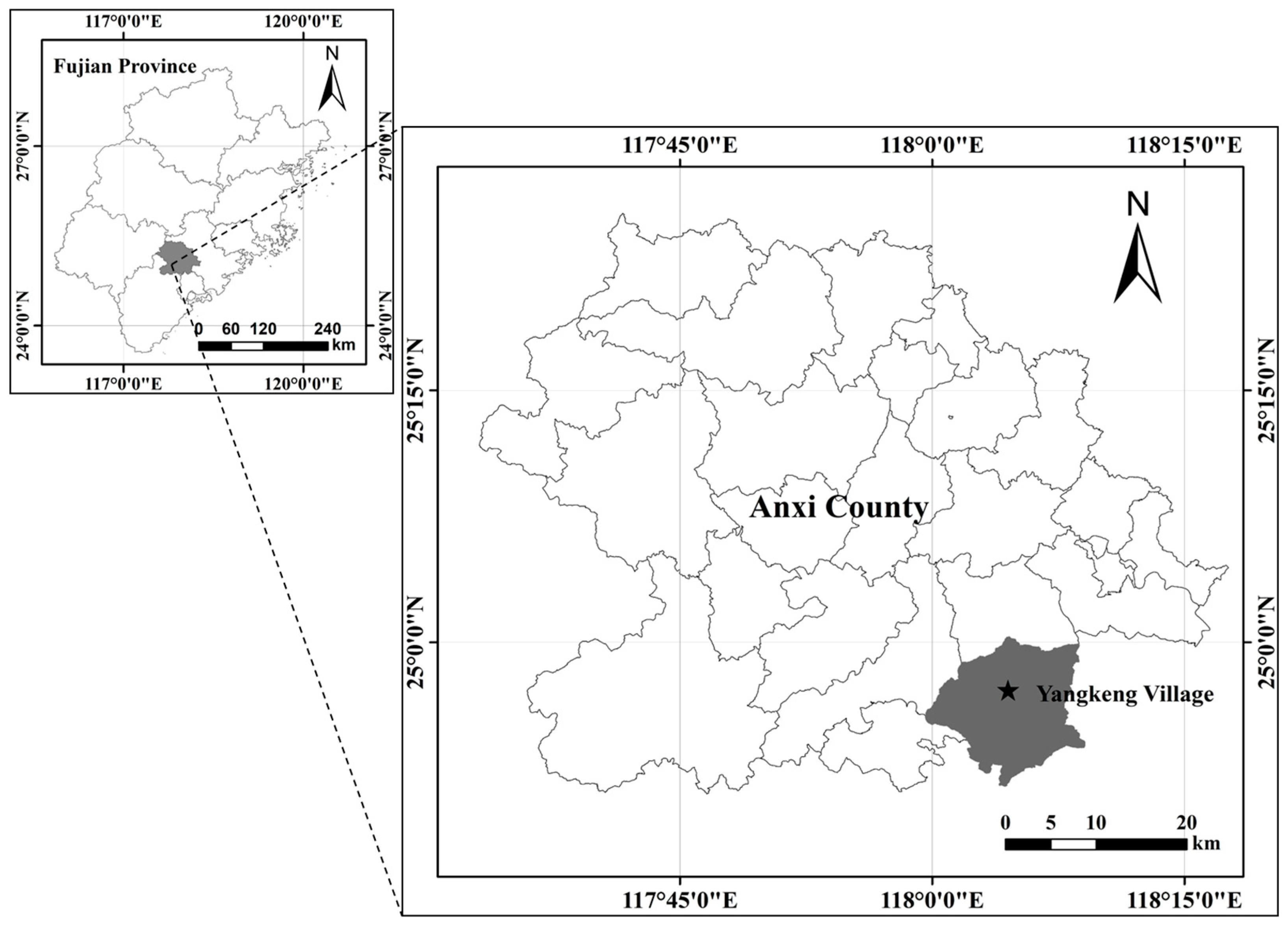
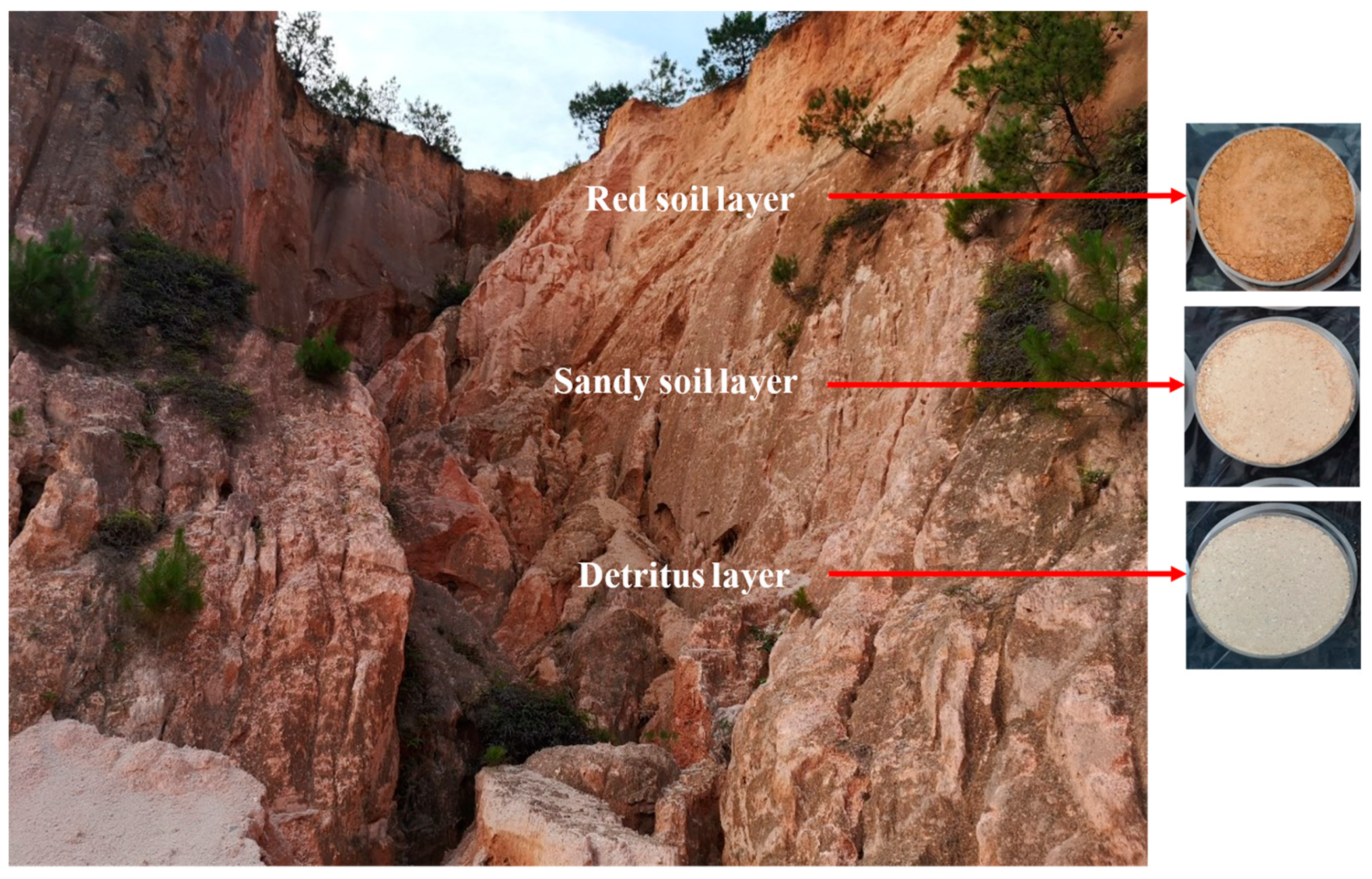
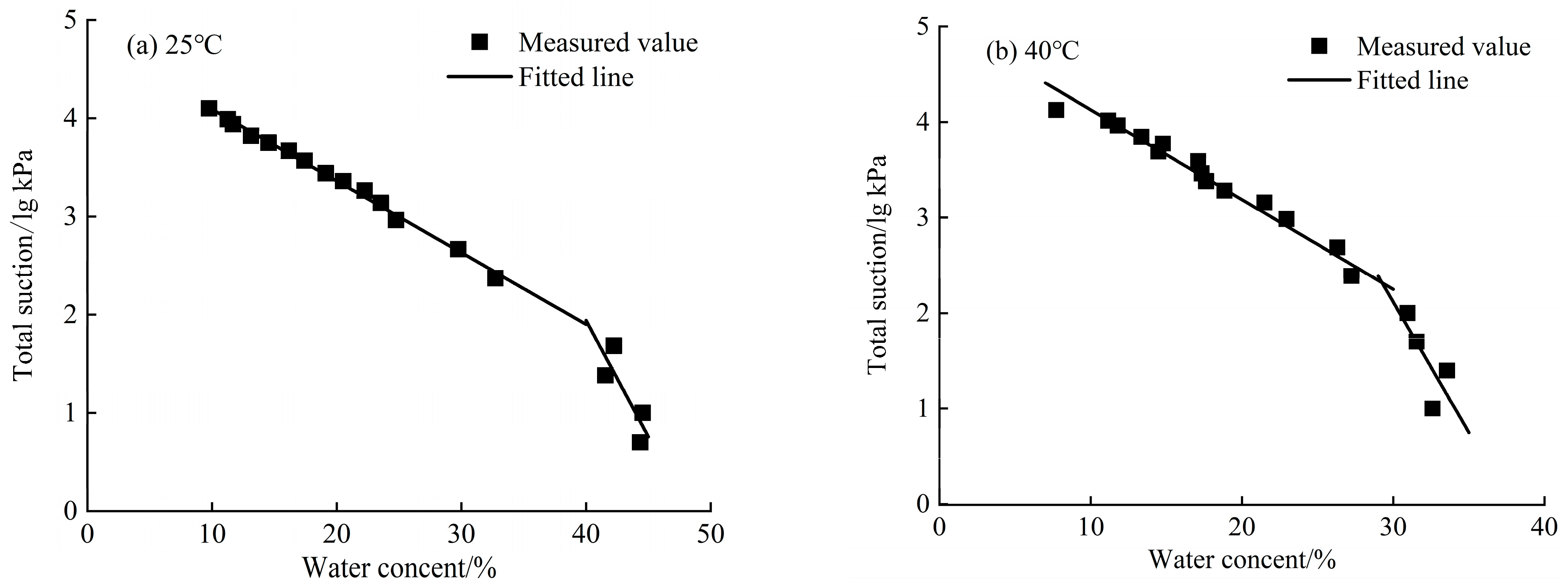
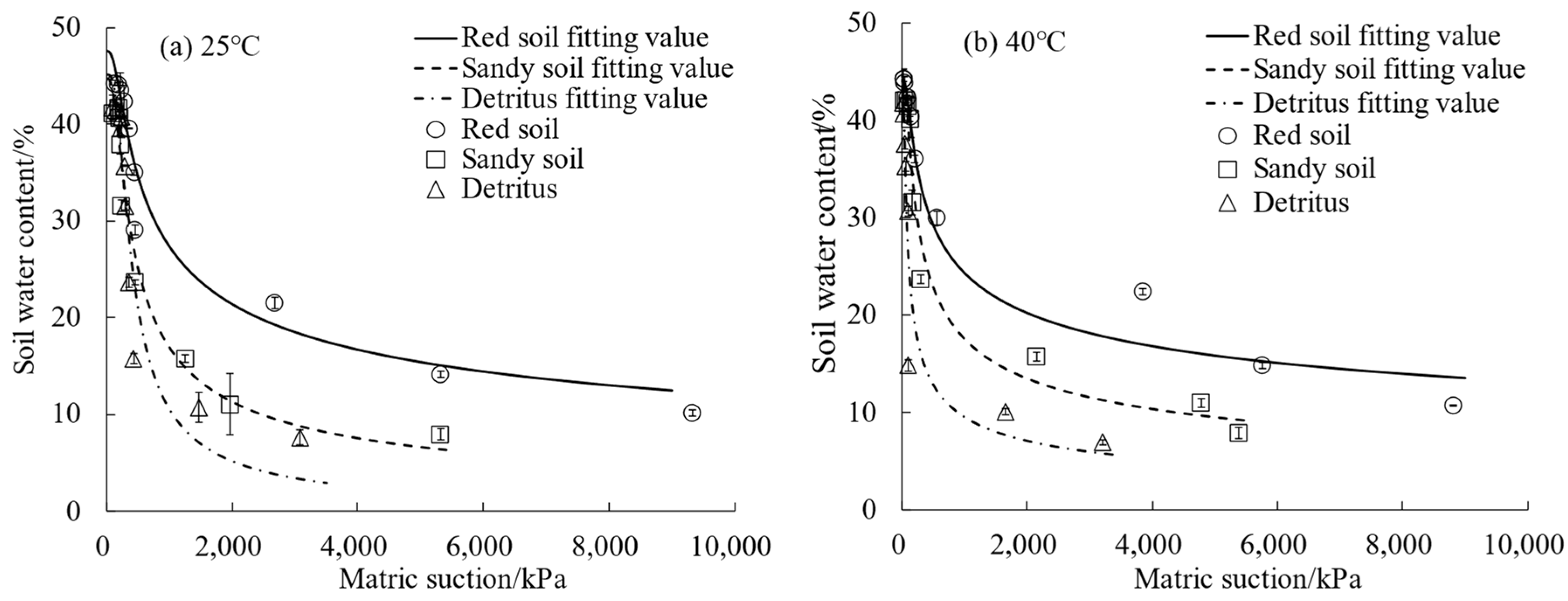
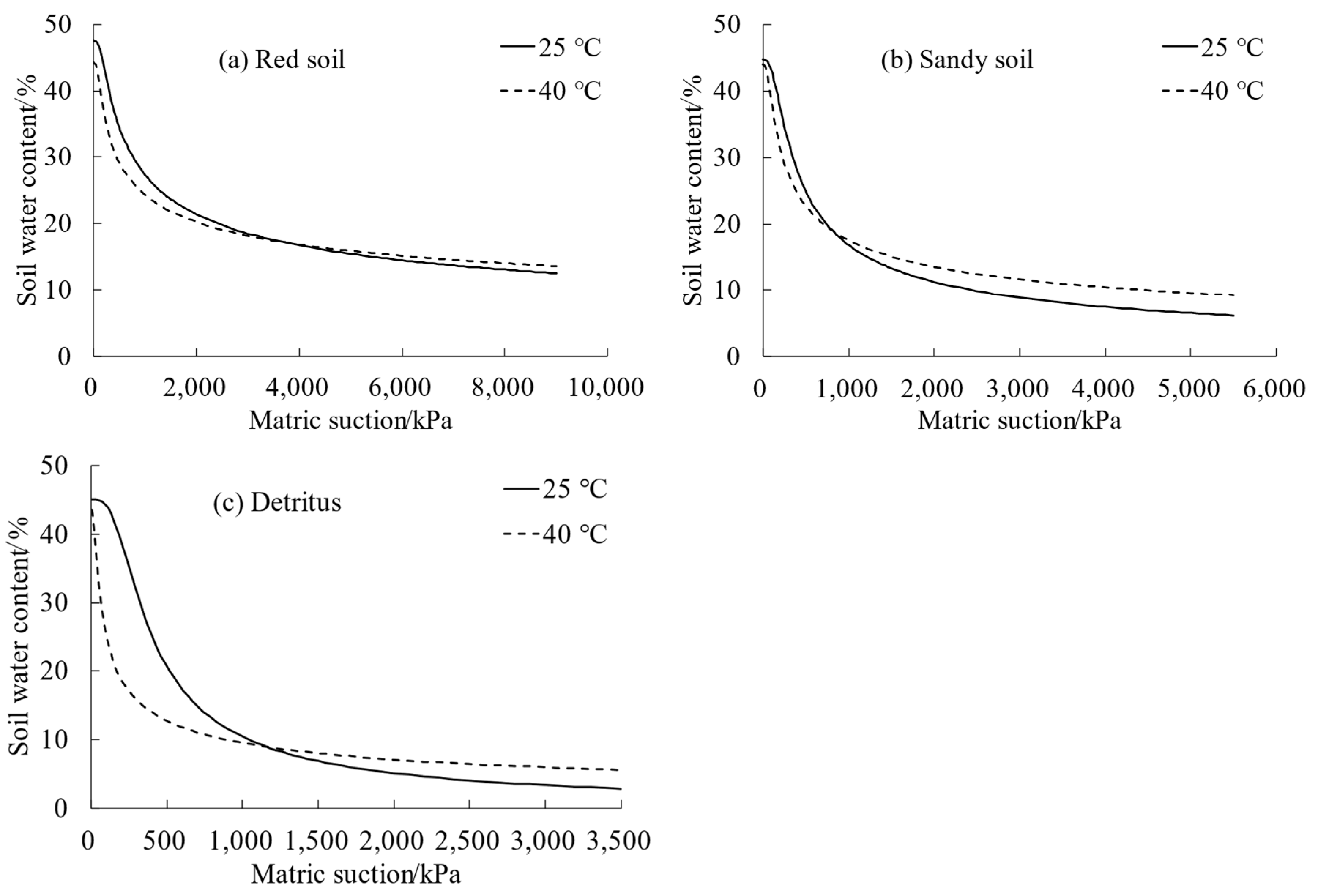

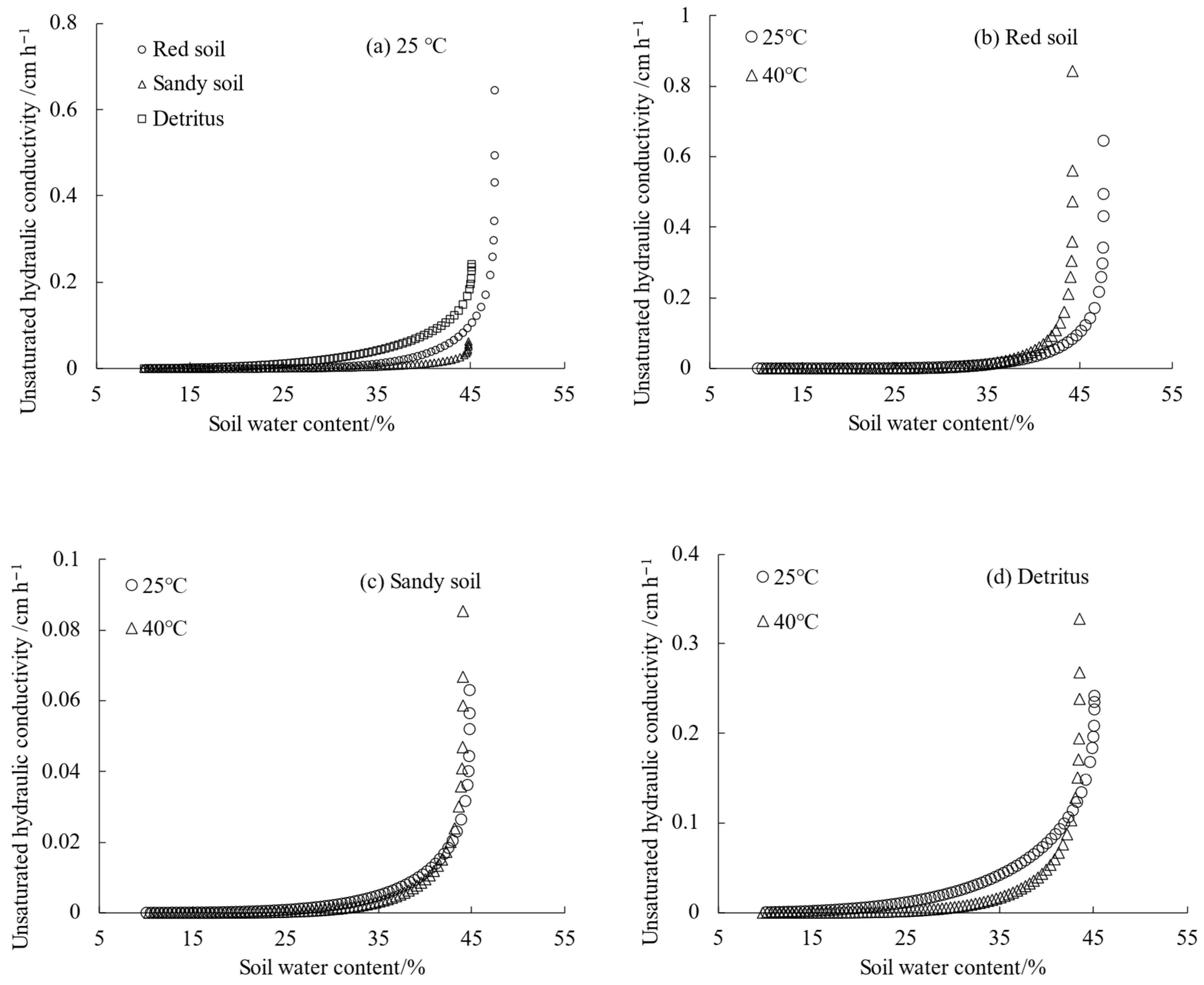
| Soil Layers | pH | 25 °C Plasticity Index | 40 °C Plasticity Index | Bulk Density /(g cm−3) | Sand /% | Silt /% | Clay /% |
|---|---|---|---|---|---|---|---|
| Red soil | 5.88 | 34.11 | 29.04 | 1.46 | 30.00 | 52.88 | 17.12 |
| Sandy soil | 5.56 | 19.37 | 20.02 | 1.56 | 43.74 | 47.29 | 8.97 |
| Detritus | 5.60 | 14.26 | 21.80 | 1.59 | 67.79 | 29.47 | 2.74 |
| Parameters | Red Soil | Sandy Soil | Detritus | |||
|---|---|---|---|---|---|---|
| 25 °C | 40 °C | 25 °C | 40 °C | 25 °C | 40 °C | |
| 0.476 | 0.440 | 0.448 | 0.441 | 0.451 | 0.435 | |
| 0.000 | 0.000 | 0.000 | 0.000 | 0.000 | 0.000 | |
| 0.047 | 0.096 | 0.053 | 0.116 | 0.041 | 0.366 | |
| n | 2.357 | 2.265 | 2.585 | 2.376 | 3.036 | 2.423 |
| m | 0.151 | 0.117 | 0.226 | 0.158 | 0.341 | 0.175 |
| R2 | 0.96 | 0.98 | 0.96 | 0.97 | 0.90 | 0.89 |
| RMSE | 0.024 | 0.019 | 0.025 | 0.024 | 0.041 | 0.044 |
Disclaimer/Publisher’s Note: The statements, opinions and data contained in all publications are solely those of the individual author(s) and contributor(s) and not of MDPI and/or the editor(s). MDPI and/or the editor(s) disclaim responsibility for any injury to people or property resulting from any ideas, methods, instructions or products referred to in the content. |
© 2024 by the authors. Licensee MDPI, Basel, Switzerland. This article is an open access article distributed under the terms and conditions of the Creative Commons Attribution (CC BY) license (https://creativecommons.org/licenses/by/4.0/).
Share and Cite
Yang, Y.; Yang, L.; Zhao, D.; Guo, Y.; Lin, J.; Jiang, F.; Huang, Y.; Zhang, Y. Thermal Effects on the Soil Water Retention Curves and Hydraulic Properties of Benggang Soil in Southern China. Water 2024, 16, 238. https://doi.org/10.3390/w16020238
Yang Y, Yang L, Zhao D, Guo Y, Lin J, Jiang F, Huang Y, Zhang Y. Thermal Effects on the Soil Water Retention Curves and Hydraulic Properties of Benggang Soil in Southern China. Water. 2024; 16(2):238. https://doi.org/10.3390/w16020238
Chicago/Turabian StyleYang, Yuke, Lu Yang, Dongfeng Zhao, Yongjia Guo, Jinshi Lin, Fangshi Jiang, Yanhe Huang, and Yue Zhang. 2024. "Thermal Effects on the Soil Water Retention Curves and Hydraulic Properties of Benggang Soil in Southern China" Water 16, no. 2: 238. https://doi.org/10.3390/w16020238
APA StyleYang, Y., Yang, L., Zhao, D., Guo, Y., Lin, J., Jiang, F., Huang, Y., & Zhang, Y. (2024). Thermal Effects on the Soil Water Retention Curves and Hydraulic Properties of Benggang Soil in Southern China. Water, 16(2), 238. https://doi.org/10.3390/w16020238





